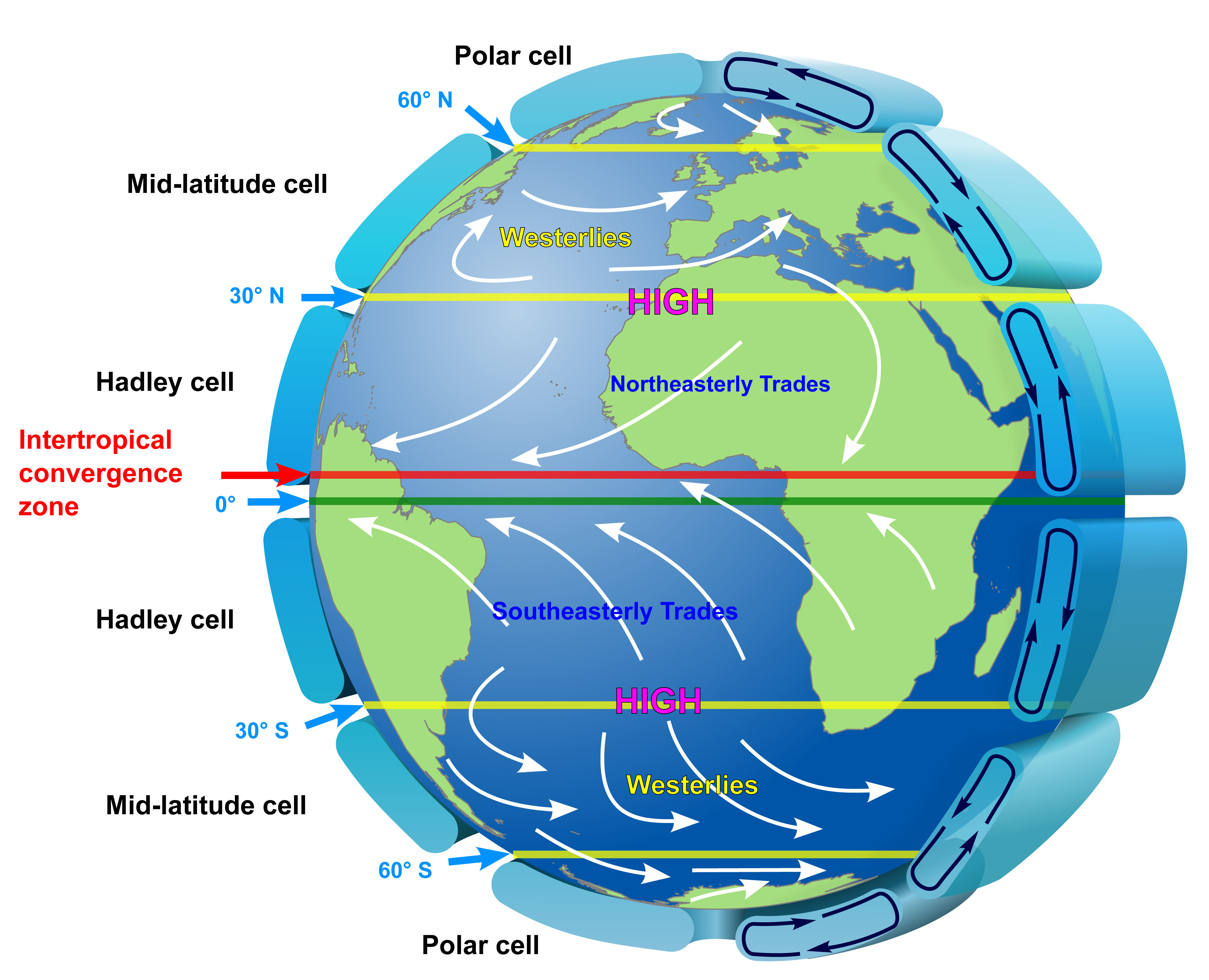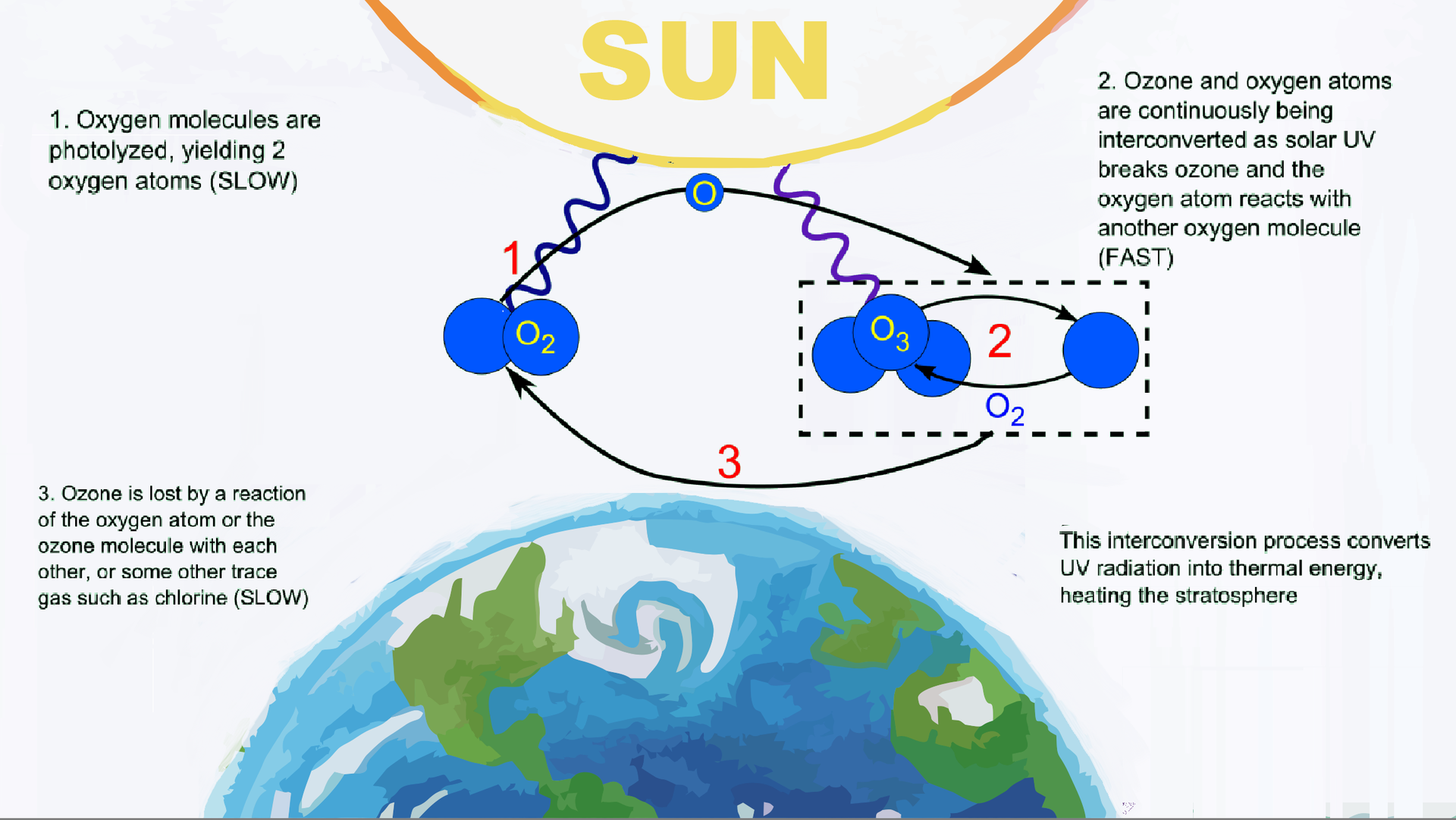8.2: Atmosphere of the Earth
- Page ID
- 30908
 The Earth's atmospheric layers.
The Earth's atmospheric layers.
8.2.1 Troposphere
Like the interior of the Earth, its atmosphere also has several layers. The lowest level, the troposphere contains the air we breathe and where our weather patterns occur. Surface heating produces convection currents in the troposphere. As the Sun’s rays warms the Earth’s surface, the air near surface absorbs heat and rises, creating convection currents. As the air rises in the troposphere, it cools, becomes denser, and sinks back toward the surface.
Three major convection cells drive the prevailing weather patterns, climate, and ocean currents. The Hadley cells consist of warm, moist air rising at the equator. As it rises, the air cools. Since cool air cannot hold as much moisture as warm air, it brings high levels of on the equator, giving its wet, warm tropical climate. The dry, cool air then sinks at 30 degrees latitude north and south, creating dry, desert climates at those latitudes. The Ferrell cells operate because the north and south latitudes of 30 and 60 degrees, creating regions of heavy rainfall as 60 degrees latitude. Finally, the polar cells operate inside the Arctic and Antarctic circles, creating regions of very little rainfall at the poles. While it may seem strange to think of Antarctica as being a region of low rainfall since it is covered in ice, it receives so little annual rainfall that it is technically a desert.
 The convection cells of the atmosphere.
The convection cells of the atmosphere.
8.2.2 The Greenhouse Effect
Sunlight that is not reflected is absorbed by Earth’s surface, warming it. The surface re-radiates as infrared thermal radiation. While most gases in the atmosphere are transparent to both visible light and infrared radiation, gases with three or more atoms in their molecules will absorb some of the infrared radiation. This produces the greenhouse effect, so named because the atmosphere traps heat much like a greenhouse does. Overall, the greenhouse effect benefits life on Earth. Without it, the temperature on the Earth would be much colder than it is and life as we know it would be impossible. However, in recent decades, atmospheric scientists have found extremely strong evidence that Earth is getting warmer. This warmer corresponds with the increase in certain gases in the atmosphere, such as carbon dioxide, a gas that is known to contribute to the greenhouse effect. The atmospheric levels of carbon dioxide have been rising since the industrial revolution in the mid-19th century. The effects of this warming is still a subject of debate, but most climatologists have concluded that it will result in continued melting of the glaciers and rising sea levels, as well as increases in intense storms in some regions and increasing droughts in others.
 The Greenhouse Effect.
The Greenhouse Effect.

8.2.3 The Upper Layers of the Atmosphere
The layer above the troposphere, the stratosphere, contains the ozone layer. Since the 1970s, scientists have known that certain chemicals, such as Chlorofluorocarbons (CFCs), have been damaging the ozone layer, resulting in an ozone hole. The ozone hole is a region of reduced ozone concentration in the stratosphere above Antarctica. The ozone layer absorbs much of the Sun’s ultraviolet radiation and without it, humans would be at risk for higher levels of skin cancer and other ailments. In response to concerns about the loss of stratospheric ozone, nations signed the Montreal Protocol in 1987, pledging to phase out production of CFCs and other ozone depleting chemicals.
 The hole in the ozone layer about Antarctica.
The hole in the ozone layer about Antarctica.
The two layers about the stratosphere are the mesosphere and the ionosphere. The ionosphere gets its name because it is ionized by solar radiation and is good conductor. This causes it to reflect waves in the AM range, though it is transparent to radio frequencies used for FM bands and TV.
8.2.4 The Oceans and the Tides
The Earth formed inside the frost line (Section 6.5), so water could not have condensed on its surface during accretion. Astronomers had once assumed that Earth’s water can been delivered by comets during the Late Heavy Bombardment period. To confirm this, astronomers studied at least four well-known comets: Halley's Comet and Comets Hyakutake, Hale-Bopp, and 67P/Churyumov-Gerasimenko. In these comets, however, they found that the percentage of deuterium (a form of hydrogen with double the mass of normal hydrogen) is twice that of what we find in average seawater. As a result, astronomers have concluded that comets probably contributed no more than 10% of Earth’s water. The current best bet is that asteroids delivered most of the Earth's water within the first 100 million years after it formed. The majority probably came from asteroids containing water ice. Jupiter’s gravity perturbed the orbits of the asteroids, sending into the inner solar system where they eventually impacted the Earth.
Once important property of the oceans is the daily rising and falling of the tides. The Moon’s gravity is the primary force that governs the motion of the tides, although the Sun’s gravity can modify the lunar tides. Tides result from the fact that the gravitational force on Earth from the Moon is unequal. The force on near side of Earth is greater than force on far side. This causes tidal “bulges” of rising water on both the near side and the far side of the Earth and low tides at 90 degrees in between as water flows out of these regions. Tides exert a “drag” force on Earth, which is slowing its rotation. As the Earth’s rotation slows, its angular momentum is transferred to the Moon, causing it to recede further away from the Earth. This will continue until Earth rotates synchronously with the Moon so that the same side of Earth always points toward the Moon. When that comes, the people on one side of the Earth will see the Moon in the sky 24 hours a day while the people on the opposite will never see the Moon again. This has already happened with the Moon, whose near side is always toward Earth.
 The Moon's gravity influences the tides.
The Moon's gravity influences the tides.

